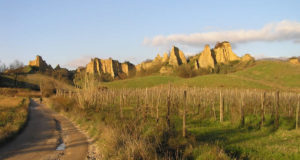![]() Français
Français ![]() Deutsch
Deutsch ![]() Español
Español ![]() Italiano
Italiano
The Apuan Alps are probably the most beautiful mountains of Tuscany, located near the sea between Garfagnana and Lunigiana are universally famous for the marble that is extracted from its quarries since antiquity.
MARBLE MOUNTAINS
The mountains are rugged and inaccessible and recall, for their rugged form, the Dolomites. Apuan Alps are now a Regional Natural Park (Parco naturale regionale delle Alpi Apuane) and an important destination for hiking, thanks to the dense network of marked trails. The area, consisting of karst terrain, is full of caves and underground cavities. The most famous and equipped from the point of view of tourism is the Grotta del Vento in Garfagnana. But on the Apuan Alps, there is also the Cave of Corchia (Antro del Corchia), a complex of tunnels and caves among the largest in the world, measuring over 150 km in length (only half explored by cavers) of which only 2 km feature for tourists.
The highest peak of the Apuan Alps is Monte Pisanino (1,946 meters) other significant mountains are: Monte Tambura (1,891 meters), Monte Cavallo (1,888 meters), Pania della Croce (1,858 m), Pizzo d’Uccello (1,781 meters), interestingly, for the presence of a large natural arch 32 meters wide and 25 meters high, is Monte Forato (1,230 meters).
The Apuan Alps are located along the border between the provinces of Lucca and Massa Carrara, these mountains are famous for their marbles, their deep abysses and large underground cavities characteristics of karst phenomena. Apuan Alps are one of the most original Italian mountain ranges for the variety of the landscape and the environment.
The Apuan Alps are a topography complex of great beauty. A few kilometers from the coastal plain of Versilia, the Apuan Alps rise to nearly 2,000 m. height with Mount Pisanino (1,947 m.).
A GREAT CAVE SYSTEM
The area has interesting geomorphological features, which make it a paradise for lovers of geology: there are moraines and other glacial structures, are also visible karst sinkholes (Carcaraia, Monte Altissimo, Monte Sagro, etc.), or meteorological erosion phenomenas (Altopiano della Vetricia, Arco del Monte Forato, “Marmitte dei Giganti”, etc.). The karst phenomenas are particularly relevant and visible in the subsoil, with the great extent of caves, cavities and abysses. Antro del Corchia, with a total length of more than 70 km of underground channels explored and a vertical drop of 1,210 m., is the largest Italian karst system and one of the largest in the world.
The traditional mining of the famous Carrara marble, caused an alteration of the landscape also this of great interest. The largest concentration of marble quarries is near the town of Carrara. There are other places where the marble is extracted as in Massa, Seravezza, Stazzema, Vagli di Sotto, Minucciano, Casola in Lunigiana, Fivizzano. The mineral wealth of the Apuan include metal rich veins of iron, copper etc.
BIBLIOGRAPHY
- AA. VV. “Toscana” Guide Rosse Touring Club Italiano, 2007
- Bogazzi, Guglielmo; Marchini, Pietro “Borghi paesi e valli delle Alpi Apuane. Origini e storia tra la valle del Magra e la valle del Serchio. Vol. 1” Pacini Editore, 2012
- Bradley, Frederick; Medda, Enrico ” Parco regionale delle Alpi Apuane” Ediz. italiana e inglese, Promorama, 2010
- Ciabatti, Giuseppe A. “Alpi Apuane. Ferrovie e sentieri. 17 itinerari da scoprire tra storia e natura” Tamari Montagna, 2013
- Perna, Giorgio; Girolami, Fabrizio “Le montagne irripetibili. Itinerari erscursionistici nel parco delle Alpi Apuane” Pezzini, 2008
- cur. Valdes G. “Guida al parco delle Alpi Apuane” Felici, 2005
- Barga and the Apuan Alps. Author and Copyright Marco Ramerini
- Apuan Alps. Author and Copyright Marco Ramerini
 Borghi di Toscana Guida ai borghi e ai paesaggi della Toscana
Borghi di Toscana Guida ai borghi e ai paesaggi della Toscana




















